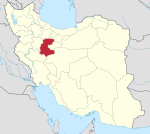Khomeyn County
History
The name "Khomeyn" was first mentioned in a book named The History of Prophets and Kings. Subterranean canals (qanats), sewers and its famous fire-temple are among the pre-Islamic relics. This region was called the center of Kamareh 200 years ago.
Demographics
Population
At the time of the 2006 National Census, the county's population was 108,840 in 29,888 households. The following census in 2011 counted 107,368 people in 33,327 households. The 2016 census measured the population of the county as 105,017 in 34,611 households.
Administrative divisions
Khomeyn County's population history and administrative structure over three consecutive censuses are shown in the following table.
| Administrative Divisions | 2006 | 2011 | 2016 |
|---|---|---|---|
| Central District | 94,106 | 94,687 | 94,109 |
| Ashna Khvor RD | 4,876 | 4,266 | 3,626 |
| Galehzan RD | 5,116 | 4,224 | 3,483 |
| Hamzehlu RD | 4,748 | 3,844 | 3,276 |
| Rostaq RD | 6,033 | 5,297 | 4,436 |
| Salehan RD | 9,302 | 7,003 | 6,406 |
| Khomeyn (city) | 64,031 | 70,053 | 72,882 |
| Kamareh District | 14,734 | 12,681 | 10,908 |
| Chahar Cheshmeh RD | 6,852 | 5,727 | 4,646 |
| Khorram Dasht RD | 6,360 | 5,457 | 4,888 |
| Qurchi Bashi (city) | 1,522 | 1,497 | 1,374 |
| Total | 108,840 | 107,368 | 105,017 |
| RD = Rural District | |||
Archaeology
According to The Journal of Orthoptera Research, in 2017-2018, a rock carving of a six-legged mantis named Empusa hedenborgii with raptorial forearms was revealed in the Teimareh rock-art site. An engraved, insect-like image has a 14cm length and 11cm width, with two circles at its sides that probably dates 40,000–4,000 years ago. This motif is analogous to the famous "squatter man" petroglyph encountered at several locations around the world.
Geography
The county of Khomeyn is located in the south of Markazi province, in a fertile plain. The climate is moderate mountainous inclining to a semi-desert. Winters are cold and summers are moderate. This county lies at a distance of 323 km. from Tehran.
Notable people
The county is currently famous as the birthplace of Ruhollah Khomeini, leader of the Islamic Revolution. His father's house has become an important historical monument.
See also
![]() Media related to Khomein County at Wikimedia Commons
Media related to Khomein County at Wikimedia Commons
References
- ^ OpenStreetMap contributors (4 January 2025). "Khomeyn County" (Map). OpenStreetMap (in Persian). Retrieved 4 January 2025.
- ^ Census of the Islamic Republic of Iran, 1395 (2016): Markazi Province. amar.org.ir (Report) (in Persian). The Statistical Center of Iran. Archived from the original (Excel) on 17 October 2020. Retrieved 19 December 2022.
- ^ Habibi, Hassan (c. 2024) [Approved 21 June 1369]. Approval of the organization and chain of citizenship of the elements and units of Markazi province's divisions to the citizenship of Arak city. lamtakam.com (Report) (in Persian). Ministry of the Interior, Political Commission of Defense of the Government Board. Proposal 3233.1.5.53; Notification 84900/T123K. Archived from the original on 18 January 2024. Retrieved 18 January 2024 – via Lam ta Kam.
- ^ Census of the Islamic Republic of Iran, 1385 (2006): Markazi Province. amar.org.ir (Report) (in Persian). The Statistical Center of Iran. Archived from the original (Excel) on 20 September 2011. Retrieved 25 September 2022.
- ^ Census of the Islamic Republic of Iran, 1390 (2011): Markazi Province. irandataportal.syr.edu (Report) (in Persian). The Statistical Center of Iran. Archived from the original (Excel) on 19 January 2023. Retrieved 19 December 2022 – via Iran Data Portal, Syracuse University.
- ^ Kolnegari, Mahmood; Naserifard, Mohammad; Hazrati, Mandana; Shelomi, Matan (13 March 2020). "Squatting (squatter) mantis man: A prehistoric praying mantis petroglyph in Iran". Journal of Orthoptera Research. 29 (1): 41–44. doi:10.3897/jor.29.39400. ISSN 1937-2426.
- ^ "Ancient mantis-man petroglyph discovered in Iran". phys.org. Retrieved 1 September 2020.
- ^ "Ancient mantis-man petroglyph discovered in Iran". ScienceDaily. Retrieved 1 September 2020.
- ^ "'Mantis-man' describes puzzling petroglyph found in Iran". Tehran Times. 17 March 2020. Retrieved 1 September 2020.
